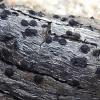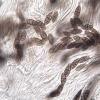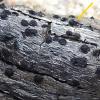
07-12-2025 16:07
Arnold BüschlenHallo, ich habe in einer Moos-Aufsammlung (epiohy

05-12-2025 17:33
 Bruno Coué
Bruno Coué
Bonjour, je serais heureux de recueillir votre avi

07-12-2025 09:24
De la pasada semana en Galicia EspañaEn el suelo

06-12-2025 00:19
 Viktorie Halasu
Viktorie Halasu
Hello, would anyone have this article, please? An

02-12-2025 18:59
This pair of ascos 2.5cm across were on recently b

02-12-2025 19:25
Buckwheat PeteHello, can anyone identify this hairy fungus growi
One more on Juniperus wood - Pleosporales
Lepista Zacarias,
24-05-2016 16:50
(16.2) 17.3 - 21.9 (22.4) × (7.3) 7.32 - 8.6 (9.1) µm
Q = (2.1) 2.2 - 2.8 (3.1) ; N = 32
Me = 19.2 × 7.9 µm ; Qe = 2.4
Any hint about it will be appreciated.
Thanks in advance,
zaca
Lepista Zacarias,
23-03-2017 01:05
Re : One more on Juniperus wood - Pleosporales
Dear all,
It took me all this time to understand that the name - Hysterobrevium mori - that I gave to a specimen collected on the same day, though at a different place, and considered at the topic
http://www.ascofrance.fr/search_forum/42906
belongs to this fungus, while the other is Oedohysterum cf. pulchrum as I concluded recently at
http://www.ascofrance.fr/search_forum/47602. />
At the time any of the genera in consideration was new to me and I was far to imagine that they are so closely related, since the macro appearance seemed diverse.
I arrive to this conclusion mainly based on the form of the spores and only after I looked again to the photo of the specimens; I took sometime to realise that at two places lirellae with a slit are visible, whereas the rest of them are deformed due to the degradation of the substrate and to the exposition to the natural elements. I upload again the photo with marks pointing to the "key places".
Summarizing, in spite of the strange looking of most of the fruit bodies of this fungus, I believe that it is Hysterobrevium mori.
Of course, I will appreciate your comments on the subject.
Regards,
zaca
It took me all this time to understand that the name - Hysterobrevium mori - that I gave to a specimen collected on the same day, though at a different place, and considered at the topic
http://www.ascofrance.fr/search_forum/42906
belongs to this fungus, while the other is Oedohysterum cf. pulchrum as I concluded recently at
http://www.ascofrance.fr/search_forum/47602.
At the time any of the genera in consideration was new to me and I was far to imagine that they are so closely related, since the macro appearance seemed diverse.
I arrive to this conclusion mainly based on the form of the spores and only after I looked again to the photo of the specimens; I took sometime to realise that at two places lirellae with a slit are visible, whereas the rest of them are deformed due to the degradation of the substrate and to the exposition to the natural elements. I upload again the photo with marks pointing to the "key places".
Summarizing, in spite of the strange looking of most of the fruit bodies of this fungus, I believe that it is Hysterobrevium mori.
Of course, I will appreciate your comments on the subject.
Regards,
zaca
Alain GARDIENNET,
23-03-2017 07:29
Re : One more on Juniperus wood - Pleosporales
Hi Zaca,
For this one, I don't know, if you don't observe the true shape of hysteriaceous ascomata it's difficult to say it belongs to Hysteriaceae but for the one collected in 2016, I agree, it's closed to your other Oedohysterium cf pulchrum.
Alain
Lepista Zacarias,
23-03-2017 10:52
Re : One more on Juniperus wood - Pleosporales
Hi Alain,
Thanks for your comment.
At the end, looking for the (3) collections I have of H. mori, all with similar size and septation of the spores, in this collection the spores have ends more obtuse, so more according to the description of the species.
The collections I named O. pulchrum were collected at he same place, in two consecutive years.
Best regards,
zaca
Thanks for your comment.
At the end, looking for the (3) collections I have of H. mori, all with similar size and septation of the spores, in this collection the spores have ends more obtuse, so more according to the description of the species.
The collections I named O. pulchrum were collected at he same place, in two consecutive years.
Best regards,
zaca








